

The ICE 1 was a great success, but there have been some problems too. The weight per seat is rather high, and for some connections the train is too long. Therefore the new ICE 2 trains, which are currently (1997) put into service, are shorter and lighter. The ICE 2 only consists of one power unit and seven cars (instead of two power units and up to fourteen cars), so it is half as long as an ICE 1. If high capacity is needed, two of them can be coupled together with a new automatic Scharfenberg coupler. They can be separated quickly at a station and leave into different directions. So, more flexible timetables become possible.
The DBAG has ordered 44 trains ICE 2 plus 2 reserve locomotives, 1 reserve cab car and 26 additional coaches for the ICE 1. The reserve locomotives are used for the ICE-S. The ordered 13 trains for international connections were cancelled, these will be versions of the ICE 3 and not the ICE 2.
One problem of the ICE 2 is that the Eisenbahnbundesamt has not yet allowed pushed trains to go faster than 200 km/h, because crosswinds might cause derailment of the cab car. The exception is the new line Berlin - Oebisfelde, where measurements have shown that the wind is not critical. The usual configuration will be powercar-train + train-powercar on the high speed lines, split up into half-trains which operate either with the powercar or the cabcar in front on old lines. The top speed of the ICE 2 will depend on the configuration, direction of travel and the lines used:
| train composition | high speed lines | Berlin - Oebisfelde | Upgraded lines | Old lines | |
| <- powercar-train | 280 km/h | 250 km/h | 200 km/h | 160 km/h | |
| powercar-train -> | 200 km/h | 250 km/h | 200 km/h | 160 km/h | |
| powercar-train + train-powercar | 280 km/h | 250 km/h | 200 km/h | 160 km/h | |
| <- powercar-train + powercar-train | 280 km/h | 250 km/h | 200 km/h | 160 km/h | |
| powercar-train + powercar-train -> | 200 km/h | 250 km/h | 200 km/h | 160 km/h | |
| train-powercar + powercar-train | 200 km/h | 250 km/h | 160 km/h | 160 km/h |
The composition with two powercars in the middle can occur if one of the two trains coming together in a station is delayed. Then, the speed on upgraded lines is limited to 160 km/h instead of 200 km/h because the two pantographs are too close together and the second pantograph couldn't follow the overhead wire still swinging from the first. This is not a problem on high speed lines, thanks to the advanced pantograph (type DSA 350 S) and the more sophisticated overhead wires used there.
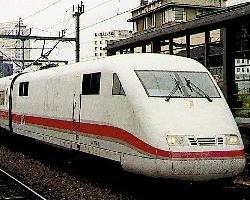

The pictures show the differences between the ICE 1 (left) and ICE 2 (right) in front view. The cab car of the ICE 2 has the same front as its power unit.
In comparison to the BordRestaurant of the ICE 1, which was a very expensive and heavy construction, the ICE 2 dining-car has been simplified a bit. It has no more `hump', and is now the same height as the other cars. Due to the shape of the carbody and for static reasons, the tables at the end of the BordRestaurant have two very narrow windows instead of the one large window of the other tables. The snack bar area has been reduced in size and offers no more seats. The crew compartments have been moved from the `service car' to the dining-car. There were plans to give up the BordRestaurant in favour of meal service at the seat (in 1st class only), but the tests in some ICE 1 trains have shown that this change would be unpopular.
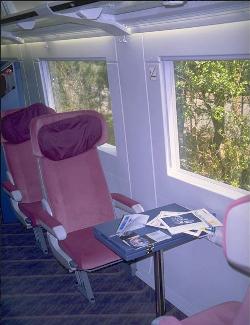
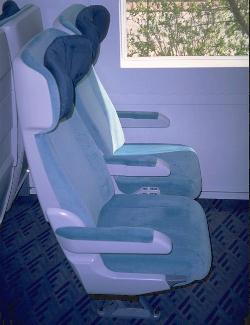
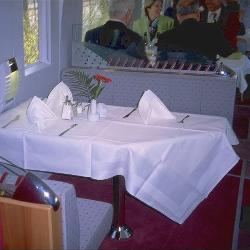
The pictures show a first class seat (left), a second class double seat (middle) and a table in the dining-car (right).
For people in wheelchairs, there is space in the 2nd class coach next to the dining-car and a WC in the dining-car. Next to the lavatory is a crew compartment and two compartments that will either have six 2nd class seats each (as compartments for people with children and handicapped persons) or be equipped as compartment for minibar trolley service and conference compartment.
Behind the driver's cab of the cab car is a machine room for pneumatic and electric equipment, with access doors for the driver, that can also serve as a compression zone in case of a collision.
| 1st class | 2nd class | |
| Seat pitch (row seat) | 980 mm | 965 mm |
| Knee space (row seat) | 868 mm | 855 mm |
| Seat width | 500 mm | 470 mm |
| Aisle width (open) | 765 mm | 536 mm |
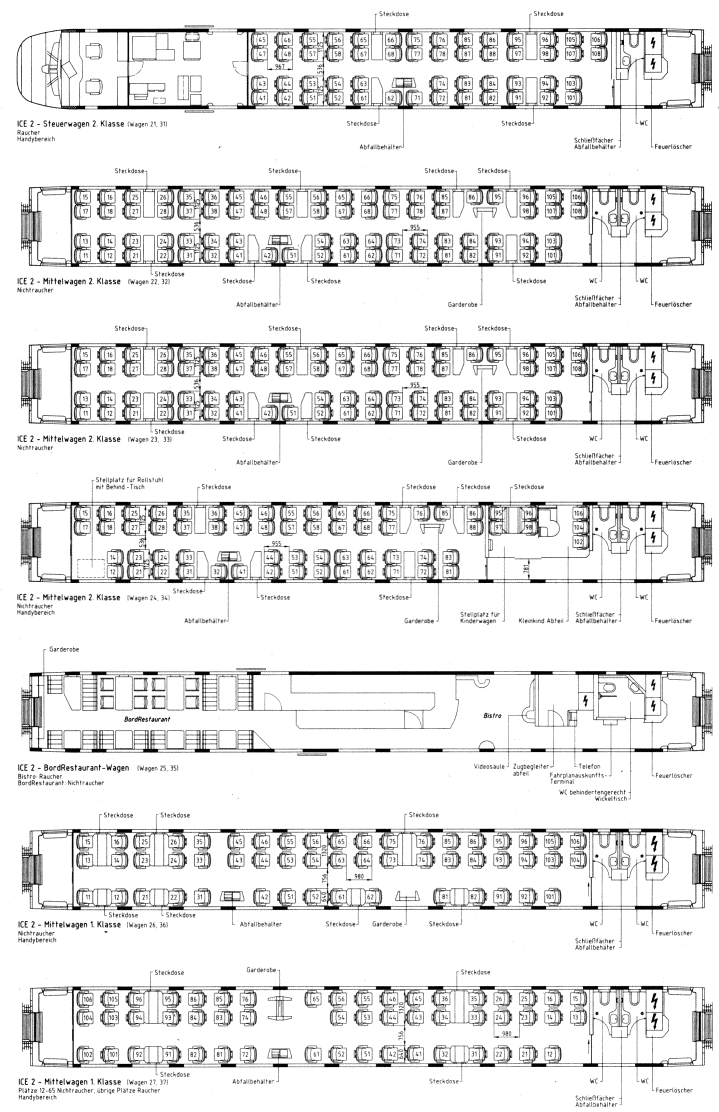
| No. | class | description |
| 402 | Locomotive, cab | |
| 17 | 8053 | 1st class (16 N/R, 14 N/T, 15 S/R, 6 S/T), 2 WC |
| 16 | 8050 | 1st class (28 N/R, 26 N/T), 2 WC |
| 15 | 807 | Dining (24 N/T), bar, kitchen, crew, 1 WC |
| 14 | 8060 | 2nd class (37 N/R, 34 N/T), 2 WC, family compartment |
| 13 | 8063 | 2nd class (39 N/R, 34 N/T), 2 WC |
| 12 | 8066 | 2nd class (39 S/R, 34 S/T), 2 WC |
| 11 | 808 | 2nd class (22 N/R, 24 N/T), 1 WC, luggage, cab |
If two trains are coupled together, the coaches of one are numbered 11 to 17, of the other 21 to 27.
For compositions of all ICE 1 and ICE 2 trainsets, see on the page of the magazine "Drehscheibe" under "Reihungen".
| in rows | at tables | in compartments | no smoking | smoking | sum | ||||
| 1st class | 59 seats (56%) | 46 seats (46%) | 84 seats (80%) | 21 seats (20%) | 105 seats (28%) | ||||
| 2nd class | 137 seats (50%) | 126 seats (46%) | 12 seats (4%) | 202 seats (73%) | 73 seats (27%) | 275 seats (72%) | |||
| sum | 186 seats (50%) | 176 seats (50%) | 8 seats (2%) | 276 seats (75%) | 94 seats (25%) | 370 seats | |||
For automatic coupling and separation of two trains, the ICE 2 has an automatic Scharfenberg coupler with fixed turning point and coupling of air tubes, brake and control cables and communication lines. The front doors of the locomotive and cab coach (similar to the TGV) are opened sideways to couple two trains.
Another change is the standard carbody: it has swinging-sliding doors at both ends, two small lavatories at one end and a passenger room with ten windows at each side (each window is 1.43 m wide with a distance of 0.55 m to the next window). So, second class coaches can be rebuilt easily into first class and vice versa. The sidewalls are rounded at the ends of each coach, so that the gap is smaller and the air resistance is decreased.
For the changes in the interior, see above.
The seats are newly developed, they take up less space and provide more leg room for the next row. So, the capacity can be increased from 48 to 54 seats in 1st class and from 66 to 75 seats in 2nd class. There is room for luggage under the seats that are arranged back to back, and the armrests can be folded up.
The ICE 2 has electronic train destination indicators outside, for better orientation especially when double trainsets are separated during the run and have different destinations (in the ICE 1, the destination is only displayed inside, next to the door). At the end of the seating areas are red LED destination indicators which show the time and the next stop. Above the seats are electronic displays for seat reservation that replace the paper signs used previously. Electric sockets (220 V ~ 50 Hz) for laptop computers and other electric gadgets have been installed near all fixed tables. There are no more reading spotlights in second class.
For emergency braking, each coach has two magnetic rail brakes in one truck that allow the train to stop at a distance of 900 m from 160 km/h.
The coaches have new trucks with pneumatic suspension for better comfort. The Austrian model SGP 400 was chosen from seven tested types. It has secondary air springs and primary steel springs and allows to accelerate to 220 km/h on old lines. Some of the bogies were built in licence by the DWA works in Vetschau.
The energy consumption per seat is reduced to about 80% because of the higher capacity per weight and greater flexibility of running single or double short trains instead of one long train.
| power unit | coach | train | ||
| length | 20.56 m | 26.40 m | 205.36 m | |
| width | 3.07 m | 3.02 m | 3.07 m | |
| height | 3.84 m | 3.84 m | 3.84 m | |
| bogie distance | 11.46 m | 19.00 m | ||
| axle distance | 3.00 m | 2.50 m | ||
| wheel diameter | 1.04 m | 0.92 m | ||
| mass | 78 t | 46.5 t (805) 47.4 t (806) 52.0 t (807) 52.8 t (808) | 418.0 t | |
| power (continuous) | 4800 kW | 4800 kW | ||
| tractive effort | 200 kN | |||
| top speed | 280 km/h | |||
| mass/length | 2.035 t/m | |||
| mass/seat | 1.13 t/seat | |||
| power/mass | 11.96 kW/t | |||
| power/seat | 13.51 kW/seat | |||
| Total area | 501.64 m² | |||
| Passenger area | 366.03 m² | |||
Meanwhile the ICE-S consists of the following vehicles:
| 410 101-0 | power car |
| 801 418-4 | middle car with measuring instruments and power cable on the roof |
| 410 102-8 | power car |
Since the first ICE 3 are completed, the ICE-S is being used for track measurement on the high speed lines.
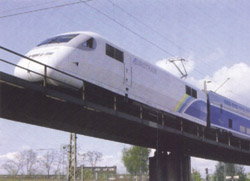
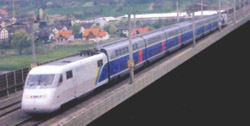
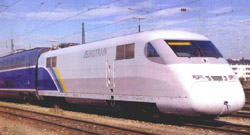
Taiwan is looking for a high-speed train for the line Taipei - Kaoshiung. The travel time on the 350 km line is today 4½ hours, it is planned to reduce it to 1½ hours. The trains, with a capacity of 930 passengers, will operate at a speed of 300 km/h, at peak hours there will be a train every three minutes. The government can choose between two offers: a system derived from the Japanese Shinkansen and the EUROTRAIN, offered by GEC Alsthom, Siemens and five Taiwanese companies.
An experimental EUROTRAIN trainset was assembled in April 1998, to demonstrate how the new train could work. It consists of the ICE 2 power units 402 042-6 and 402 046-7 and the 8-section passenger unit of the TGV Duplex No. 224. Both power cars are electrically connected via the high voltage roof cable in the middle cars. Fibre connectors and a control cable have also been installed on the roof. The ICE 2 power cars have been equipped with standard buffers and screw coupling to go together with the TGV middle cars, there is no gangway connection between the power cars and the middle cars. The middle cars have a 550 V DC power line, which is fed by a rectifier in the fourth middle car. The appearance of the power cars has been changed with coloured foils, but there is still an unsightly gap to the middle cars and a difference in height - the final train will certainly look different.
If the EUROTRAIN is chosen, the German overhead wire system Re 330 and the German signalling system LZB 80 will be installed in Taiwan, together with French switches and French signal-box technology. It is planned to take the system into operation in 2003.
Fleischmann is producing a model of the ICE 2 in H0 scale, slightly shortened (1:93). The basic set consists of a power car and a cab car, all six types of middle cars are available so you can form a prototypical consist. The power car and cab car can be equipped with front couplers after removing the front covers. This is probably the most prototypical ICE 2 model on the market. It is available for the digital FMZ system as well, but not for märklin's AC system.
Märklin has introduced a model of the ICE 2 for the AC system, Delta and Märklin Digital in 1997. Technically it is similar to the model of the ICE 1; again all cars are being offered, the length scale of 1:100 for the middle cars is the same again too. The novelty is that after removing the front covers, two trains can be coupled together as in reality. However the coupling itself doesn't look very realistic, it is just a bar below the coupler imitations. Certainly, for most modelers, the ICE 2 is a better choice as a realistic trainset takes a lot less space. For 1999, a start set with an ICE 2 (possibly simplified) is announced.
For 1998, Fleischmann has announced a less shortened ICE 2 model, in the same 1:93 length scale as their ICE 1. All versions of the middle cars are produced, so that a prototypical composition is possible. Interior light can be installed by the modeller. After removing the bow cap on the front, the power car and the cab car can be equipped with an automatic coupler to combine two trainsets (more realistic coupler position than in the märklin model, but two coupled trainsets won't operate on directly opposite curves). As a simplified version (motor without flywheel, less accurate pantographs without electric function) this ICE 2 is offered in a start set too.
Fleischmann is producing the only model of the ICE 2 in N since 1998. All versions of the middle cars are produced, so that a prototypical composition is possible. Interior lighting can be installed by the modeller. After removing the bow cap on the front, the power car and the cab car can be equipped with an automatic coupler to combine two trainsets (but two coupled trainsets won't operate on directly opposite curves). As a simplified version (motor without flywheel, less accurate pantographs without electric function) this ICE 2 is offered in a start set too.